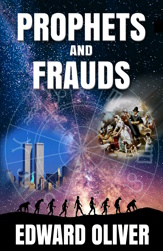
St. Malachy's 113th pope?
In 1143 A.D., an Irish Catholic archbishop named Malachy O'Morgan recorded the "Prophecy of the Popes" using brief Latin phrases to describe 112 popes from Celestine II until the papacy of "Petrus Romanus" the 112th and last pope on St. Malachy's list, who many people thought might be the "Last Pope" of the Catholic Church. Malachy's prophecy is printed below:
"During a final persecution of the Roman Church, sits Petrus Romanus, who will feed his flock through many tribulations. This accomplished, the seven-hilled city (Rome) will be destroyed, and the Dreadful Judge will judge His people."
Saint Malachy
On February 28, 2013, when Pope Benedict XVI unexpectedly announced his resignation from the papacy, the cross on the dome of Saint Peter's Basilica was struck twice by lightning, and the Internet was quickly ablaze with rumors about the impending election of Petrus Romanus, the "Last Pope" of the Catholic Church. Then, after 13 more days passed without a sitting pope, it was on the 13th day of March in the 13th year of the new Millenium, at exactly eight hours and 13 minutes in the evening, when the newly elected pope, Francis I, the two hundred and 66th pope, finally appeared on the balcony of St. Peter's Basilica on a cold and rainy night.
The election of "Petrus Romanus," or "Peter the Roman," caught prophecy watchers by surprise when pope "Peter" turned out instead to be pope "Pedro," the first LATIN AMERICAN pope elected to the papacy. And please note that this website posted its greeting to "papa Pedro" over a month BEFORE his election to the papacy. Petrus Romanus translates to "Pietro de Romano" in modern Italian, and when the pope was asked to name himself, he decided to call himself "Francis," after St. Francis "de Pietro" of Assisi. It was then later discovered that the family of Pope Francis I originally came from the small town of "Romano" in northern Italy.
While an examination of the prophecy does seem to indicate that pope Francis I was the 112th pope on St. Malachy's list, the prophecy only says Francis I will "feed his flock through many tribulations." The church has endured many attacks during the reign of pope Francis and Francis did act to defend the church from those attacks. But the phrase "this accomplished" may mean the Vatican's destruction won't occur until AFTER pope Francis completes his task of "feeding his flock through many tribulations." And so it may be the 113th pope that follows Francis I who'll witness the "ruination" of Rome.
The St. Malachy, Fatima, and Garabandal prophecies all describe a future attack on the Vatican, and it's strange that all these prophecies came out of the Vatican library vaults. Prophecies normally have more than one source, but the Saint Malachy prophecy has only one source. Prophecies normally have multiple sources, but the identity of the pope under whom this one will take place is only supported by a single source, Saint Malachy. And now that Pope Francis has passed away and pope Leo XIV has been installed as the 113th pope (after Cellestine II), it will be interesting to see if he'll be the pope who'll insult another religion and initiate Rome's ruin, thus fulfilling the St. Malachy prophecy. If you'd like to learn more about how the Hebrew prophets accurately predicted events happening in our world today, just click on one of the secure book links on this webpage to order your book by Edward Oliver.
Copyright 2004-2025 Edward Oliver
USE THIS SECURE AMAZON LINK
TO ORDER A BOOK OR EBOOK:
